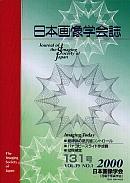Volume 60, Issue 2
Displaying 1-13 of 13 articles from this issue
- |<
- <
- 1
- >
- >|
Regular Paper
-
2021 Volume 60 Issue 2 Pages 112-119
Published: April 10, 2021
Released on J-STAGE: April 10, 2021
Download PDF (1446K) -
2021 Volume 60 Issue 2 Pages 120-126
Published: April 10, 2021
Released on J-STAGE: April 10, 2021
Download PDF (1479K)
Rapid Communication
-
2021 Volume 60 Issue 2 Pages 127-132
Published: April 10, 2021
Released on J-STAGE: April 10, 2021
Download PDF (1581K)
Imaging Today
-
2021 Volume 60 Issue 2 Pages 134-139
Published: April 10, 2021
Released on J-STAGE: April 10, 2021
Download PDF (1682K) -
2021 Volume 60 Issue 2 Pages 140-148
Published: April 10, 2021
Released on J-STAGE: April 10, 2021
Download PDF (1261K) -
2021 Volume 60 Issue 2 Pages 149-156
Published: April 10, 2021
Released on J-STAGE: April 10, 2021
Download PDF (3115K) -
2021 Volume 60 Issue 2 Pages 157-161
Published: April 10, 2021
Released on J-STAGE: April 10, 2021
Download PDF (1038K) -
2021 Volume 60 Issue 2 Pages 162-168
Published: April 10, 2021
Released on J-STAGE: April 10, 2021
Download PDF (2064K) -
2021 Volume 60 Issue 2 Pages 169-177
Published: April 10, 2021
Released on J-STAGE: April 10, 2021
Download PDF (1568K) -
2021 Volume 60 Issue 2 Pages 178-185
Published: April 10, 2021
Released on J-STAGE: April 10, 2021
Download PDF (2427K) -
2021 Volume 60 Issue 2 Pages 186-193
Published: April 10, 2021
Released on J-STAGE: April 10, 2021
Download PDF (2072K)
Imaging Highlight
-
2021 Volume 60 Issue 2 Pages 194-198
Published: April 10, 2021
Released on J-STAGE: April 10, 2021
Download PDF (1224K)
Lectures in Science
-
2021 Volume 60 Issue 2 Pages 199-206
Published: April 10, 2021
Released on J-STAGE: April 10, 2021
Download PDF (1481K)
- |<
- <
- 1
- >
- >|
